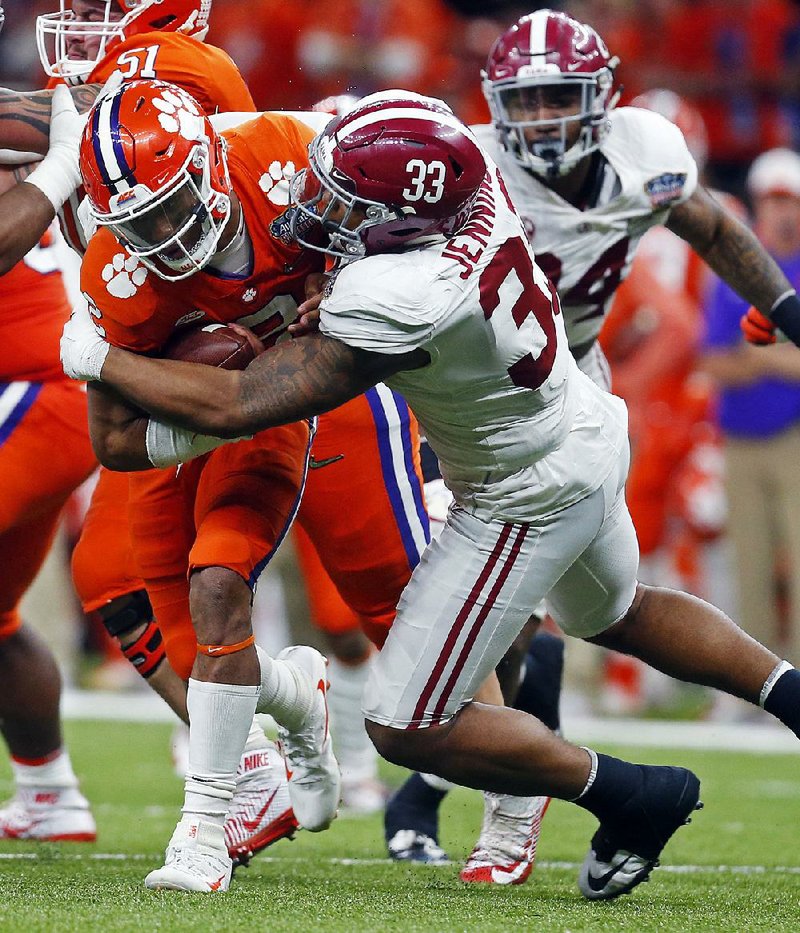ATLANTA -- As Alabama All-America defensive back Minkah Fitzpatrick watched a YouTube video of last week's thrilling Rose Bowl between Georgia and Oklahoma, there was a sense of familiarity with the Bulldogs.
"We basically run the same defense. They added a couple of things just like we add some things," Fitzpatrick said. "Even the hand signals and stuff are pretty similar. It's pretty interesting."
Not surprising, though.
Georgia Coach Kirby Smart spent eight years as defensive coordinator for Alabama Coach Nick Saban. Alabama's defenses have ranked in the top 20 nationally in yards per play every season since '08. The Tide has been ranked in the top 10 in six of those seasons.
Defense has been the backbone of four national championship teams, and both the No. 3 Bulldogs and the No. 4 Tide bring top-10 defenses into the College Football Playoff national championship game on Monday.
Saban's defenses -- and now Smart's, too -- are detail-oriented, fundamentally sound and diverse. Saban's defensive playbook is expansive, and formations can be confounding for opposing quarterbacks to decipher before the ball is snapped. Playing defense for Saban requires not just talent -- and there is so much talent -- but smarts and discipline.
"He's going to run every defense known to man or at least have the ability to do so," said Chris Brown, author of The Essential Smart Football and The Art of Smart Football.
Saban was defensive coordinator with the Cleveland Browns for Bill Belichick from 1991-94, and the two share similar philosophies.
The basics are this: 3-4 alignments that start with stout defensive linemen, who occupy blockers and can clog multiple gaps up front. This year's Alabama team has 308-pound Da'Ron Payne at nose guard. Georgia has 305-pound nose John Atkins.
"I think you have to be good up the middle," Alabama defensive coordinator Jeremy Pruitt said. "Big guys up front."
As college offenses have become more spread out, Saban and Smart and Georgia defensive coordinator Mel Tucker, who worked for Saban at LSU and Alabama, have adjusted. When facing offenses that line up with three or more wide receivers, the defense shifts to four-man fronts and usually five defensive backs. And with so many teams playing offense up-tempo these days, a key is having versatile players who can be cross-trained at multiple positions. The personnel does not have to change if the defense changes.
Tight, press coverage is typical on the outside and a concept called pattern matching is often used. Think of it as football's version of basketball's matchup zone.
"They're playing zone until someone comes into their space and then they play man," SEC Network analyst and former Auburn offensive lineman Cole Cubelic said. Defenders determine which receiver they are taking by reading the routes.
"They're going to challenge receivers and not give up easy stuff, and that comes from (Saban's) time with Belichick, where he learned a lot of sophisticated defensive coverage and concepts," Brown said. "It's not what Saban calls country zones, where you just drop to a spot and watch the quarterback's eyes."
Add in those hard-to-move defensive linemen allowing agile linebackers to fill holes and the basic offense schemes -- short throws and between the tackle runs -- rarely are productive against Saban's defenses.
"They do a great job of denying easy offense," said Miami's Manny Diaz, regarded as one of the top defensive coordinators in the country.
Brown said Saban's defensive playbook when Saban coached the Miami Dolphins was famously 1,400 pages.
"The menu is huge. All the checks and adjustments are huge," said Temple Coach Geoff Collins, who spent a season working for Saban at Alabama before becoming a defensive coordinator at Mississippi State and Florida. "But what they'll apply to each game they won't pull from the entire playbook."
And the defenses are not always what they seem.
"They just do a good job of knowing what look they're giving (an offense) and having a compliment off of that look," Collins said. "Everything is built off of having a coverage and having a pressure off of the exact same look, and a change-up. They always have a complimentary package off of every disguise."
All those Xs and Os are important, but really there is no secret sauce to stopping offenses.
Plenty of teams are using similar schemes and not getting the same results because they don't get the same level of players. All-Americans such as Fitzpatrick and Georgia linebacker Roquan Smith can make most coaches look good. Where the coaching shows up most is not necessarily in the schemes, but in technique and effort.
"They're going to be coached tough," said Georgia receivers coach James Coley, a former offensive coordinator at Florida State and Florida. "The players that play embrace that toughness. Detailed with their technique, from the way they shoot their hands to how they disengage, how they press, how they jam. How they cover and trail. There is a lot of attention to detail."
Sports on 01/07/2018
